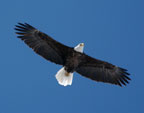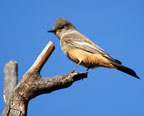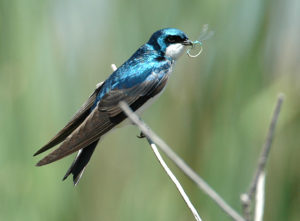How delightful to finally be getting a few Spring-like days! We had such an enjoyable stroll through the DBG at Chatfield on Saturday morning. Lots of singing going on, and a profusion of green leaves emerging everywhere.
So, part of what we did not see was a big variety, or large numbers, of waterfowl. Many species will be heading north shortly, and some have begun to do so already, but there should still be good representation by just about all of our wintering ducks. We just fell a bit short of what I anticipated we would see. We, also, did not see a few of the migrant species that are on the verge of arriving from the south. Marsh Wrens and Swainson’s Hawks have just started appearing in the area, but we saw none. Other species, such as Blue Grosbeaks and Bullock’s Orioles, are really not expected to show up for another three to four weeks.
So, what did we see? Well, we did well in the raptor department seeing a few soaring Turkey Vultures, both Golden and Bald Eagles, a Cooper’s Hawk visiting a possible nest site, a couple of Red-tailed Hawks, an active Great Horned Owl nest with mom and three nestlings, and a single American Kestrel. We hoped for a late Ferruginous Hawk or an early Swainson’s Hawk, but had no luck.
We had a few other nice surprises, including great looks at a pair of Eastern Phoebes. Historically, these guys were only found breeding in rimrock canyons and riparian woodlands in southeastern Colorado. However, with increasing frequency Eastern Phoebes are now being recorded breeding along the front range foothills in Jefferson, Boulder, and Larimer Counties. This pair was hanging out in low vegetation along Deer Creek, and even finding perches on small boulders adjacent to the creek. They can be identified by being somewhat larger than a Western Wood-Pewee, having a dark head, light gray vest, light yellow belly, dark tail, and a distinctive tail-wagging motion.
The Say’s Phoebe is a close relative of the Eastern Phoebe, being in the same genus Sayornis, and we got to see and hear several of them. They occur in our area much more commonly, with even a few electing to spend winters here, so they are not unexpected. Swallows tend to start arriving each spring during the first part of April, and we were fortunate to see both Violet-green and Tree Swallows. We also got great looks at a few Ruby-crowned Kinglets, even getting to see the ruby crown being partially displayed on one.
And, just as an odd occurrence, we had three Common Ravens but no American Crows. Kind of the opposite from what one might expect.
Good birding!
Chuck
Denver Botanic Gardens at Chatfield, Apr 6, 2019
37 species (+1 other taxa)
Canada Goose 15
Northern Shoveler 4
Gadwall 16
Mallard 11
Common Merganser 4
Rock Pigeon (Feral Pigeon) 9
Eurasian Collared-Dove 1
American Coot 1
Killdeer 2
Ring-billed Gull 3
Turkey Vulture 3
Golden Eagle 1
Cooper’s Hawk 1
Bald Eagle 1
Red-tailed Hawk 2
Great Horned Owl 4
Downy Woodpecker 3
Northern Flicker 4
American Kestrel 1
Eastern Phoebe 2
Say’s Phoebe 4
Blue Jay 2
Black-billed Magpie 5
Common Raven 3
Tree Swallow 1
Violet-green Swallow 5
Black-capped Chickadee 5
White-breasted Nuthatch 2
Ruby-crowned Kinglet 3
American Robin 15
European Starling 9
House Finch 6
Dark-eyed Junco (Pink-sided) 1
Dark-eyed Junco (Gray-headed) 2
Song Sparrow 6
Western Meadowlark 5
Red-winged Blackbird 14
Common Grackle 2






Comments
Write Comment